Market Views: HDD Shipments Down 20% in Q1 2016, Hit Multi-Year Low
by Anton Shilov on May 12, 2016 8:00 AM ESTShipments of Client HDDs as a function of all Client Drives Drop
Long gone are the days when shipments of client HDDs by Seagate and Western Digital were around 75 million units per quarter. When PC sales drop to 60 – 66 million of units per quarter, it is simply impossible to sell that many drives. The two leading makers of HDDs supplied 45.7 million of hard disks in Q1 2016, down from 63.4 million from the same quarter last year. While Toshiba’s consumer drives should not be forgotten, it is evident that the increasing amount of new PCs use SSDs these days.
The SSD adoption rate in the notebook market in Q4 2015 was approximately 25~26%, according to TrendForce. In the first quarter that figure could easily go up because Seagate admitted that it did not want to play a part in certain areas of the low capacity notebook market. Moreover, as HDD platforms get more expensive in the coming years, hard drive makers may simply leave low-end bulk storage to SSD makers. In the end, it is relatively easy to build SSDs these days (it is not easy to manufacture NAND flash, of course), but HDD production involves a lot of R&D and state-of-the-art manufacturing facilities. As a result, companies like Seagate or Western Digital may simply lose interest in entry-level hard drives, especially given the fact that soon Western Digital will become a supplier of consumer SSDs as well.
As pointed out in the previous report, Seagate includes shipments of hard disk drives it sells for game consoles into its 2.5” client HDD category, whereas Western Digital includes its drives for consoles into its consumer electronics category. As a result, the picture is somewhat noisy here. Seagate sold 10.6 million 2.5” client HDDs in the first quarter, which is a drop of 37% from the same period a year ago. Since the company deliberately decided not to fight for low-end notebook deals, such a sharp decline is not something unexpected. Meanwhile, Western Digital supplied 13.6 million of its 2.5” client hard drives in Q1 2016, 28% less than in the same quarter last year.
Sales of client 3.5” HDDs by Seagate and Western Digital declined by 22.8% year-over-year, in line with the deterioration in the HDD market. Moreover, actual shipments of desktop hard disks were on the same level for the two leading makers: Seagate supplied 10.8 million units (a 24.5% drop YoY), whereas Western Digital shipped 10.7 million devices (a decrease of 21% YoY). We do not know how many 3.5” client hard drives Toshiba shipped in Q1, but it is safe to say that the market is on the decline in general and it does not make a lot of sense to fight for desktop market share these days.
In its recent conference call with investors and financial analysts, Seagate re-emphasized that it expected sales of its client drives to continue declining, but to keep gaining capacity. Historically, sales of Seagate’s client HDDs accounted for 60% of its revenue, whereas sales of enterprise products accounted for 40% of its revenue. Given the current market trends away from installing HDDs into tablets, 2-in-1 hybrid PCs or ultra-thin notebooks, client HDD revenue will eventually drop to 40% of Seagate’s revenue whereas enterprise hard drives will account for 60% of its revenue, the company revealed. With that said, it is expected that Seagate will focus on higher-capacity drives rather than on inexpensive devices that help to boost unit sales, as the latter is not something that is needed ion a weakening market.
Sales of External HDDs and NAS Fall
Because the number of PCs that cannot house more than one internal storage device is growing, external storage is getting some traction. Seagate and Western digital offer broad lineups of DAS and NAS devices under their own trademarks as well as under G-Technology and LaCie brands. While shipments of branded storage products do not drive huge volumes, this is a rather lucrative business for manufacturers offering higher ASPs.
Sales of branded DAS and NAS devices by Seagate and Western Digital totaled 10.357 million units in the first quarter of 2016, down 7.5% from 11.190 million units in Q1 2015. The two manufacturers sold an equal amount of external storage products: Seagate shipped 5.200 million branded devices (up 2% YoY), whereas Western Digital sold 5.157 million branded products (down 15.3% YoY). Historically, Western Digital outsold its main competitor with its My Cloud and My Passport external HDDs, but in the recent quarters Seagate has begun to catch up whereas sales of WD began to decline.
One thing that should be kept in mind when analyzing branded storage is that no matter how many HDDs are inside a DAS or a NAS, they are all considered as one unit (e.g., a WD My Book, a WD My Book Duo and a fully-populated My Cloud DL4100 are equal from accounting perspective). As a result, while we do see that unit sales of branded external storage by the two large makers have been slowly declining in the recent quarters, we do not know anything about the exact amount of drives inside as well as their storage capacities.
Consumer Electronics Still Consume A Lot of HDDs
The vast majority of consumer electronics (CE) devices nowadays use NAND flash memory. However, applications like set-top-boxes, DVRs, surveillance systems and game consoles remain sizeable consumers of hard drives, which is why makers of HDDs develop platforms specifically tailored for such devices.
Since shipments of Seagate’s CE HDDs do not include drives it supplies for game consoles (they are included in client 2.5” HDD sales), its CE business looks relatively stable and mostly driven by seasonality. In the first quarter of 2016, Seagate sold 5 million of CE HDDs, slightly up from 4.8 million supplied in the same period a year ago.
By contrast, Western Digital recognizes HGST Travelstar HDDs for Sony’s PlayStation 4 as consumer drives, which is why its CE numbers significantly depend on the production of PS4. Since in Q1 console sales and manufacturing are not on the rise, sales of Western Digital’s CE HDDs declined to 7.3 million units, down 15.2% from Q1 2015. The reasons for the drop are unclear - perhaps Sony decided to slow down PS4 production, or perhaps shipments of some other Western Digital products were not strong.
Anyway, due to account policies of the two leading makers of hard drives, it is impossible to compare their CE HDD businesses directly.


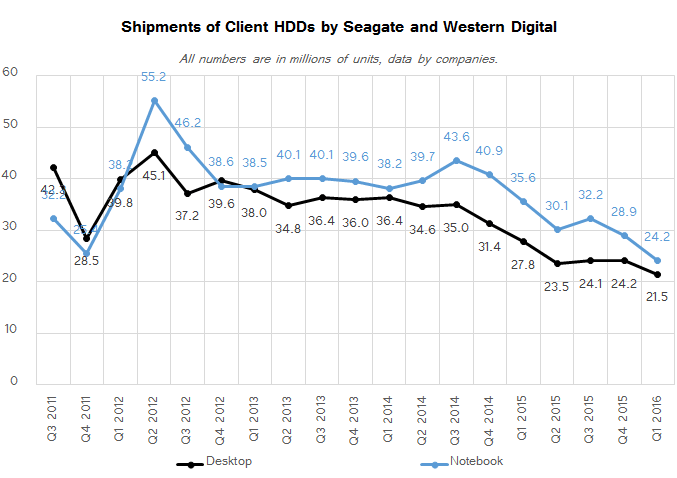
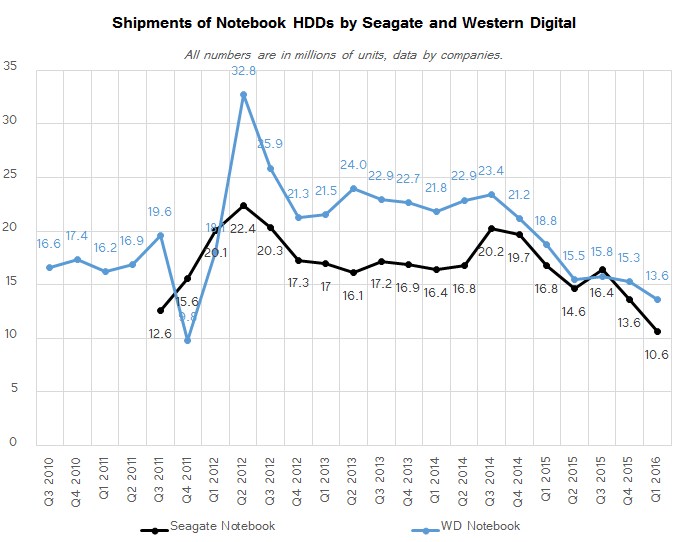
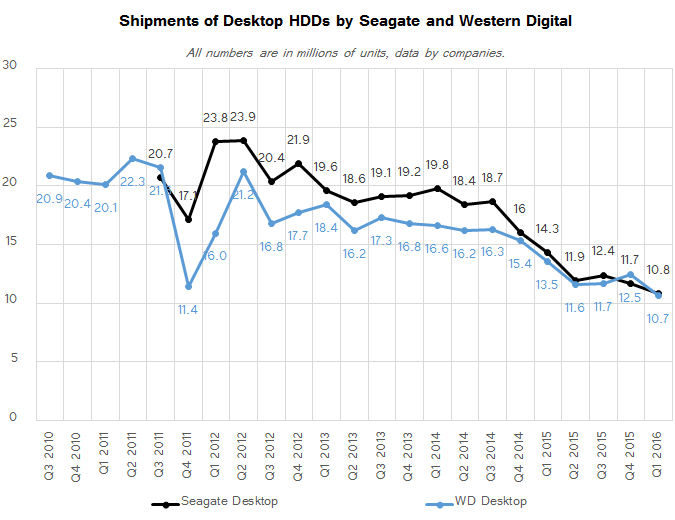
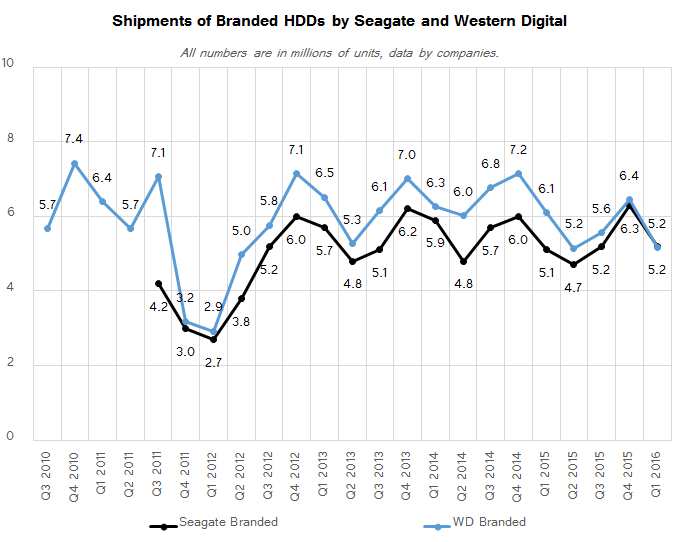
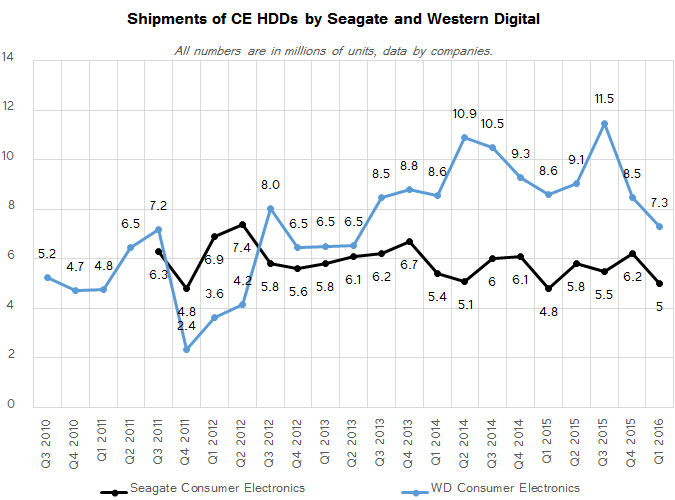








116 Comments
View All Comments
yannigr2 - Thursday, May 12, 2016 - link
I have enough space to not buy a hard disk drive the next 2-3 years. I think I bought my last HDD 2 years ago. Probably this is the case with most people and with SSDs taking the place of boot drives, HDD companies are losing the low capacity market.For most people who build new systems, they wouldn't know what to do with all that space a 240GB SSD will offer them. No second HDD for them, not to mention that a 128GB USB flash drive sometimes will do the trick, if they need to clean up some space from their SSD, without having to call the technician to install the HDD. On the other hand, people who need space will go for one 4TB or bigger drive, probably external, instead of buying more HDDs with lower capacities to put into their PC case.
Old PCs have enough capacity, new PCs go for an SSD or just a single high capacity HDD, instead of many with lower capacity.
Gigantopithecus - Thursday, May 12, 2016 - link
This. Last year I built about 30 desktop computers for typical home users (i.e., office/light productivity, HTPC, and gaming rigs) - three had a spinning hard drive in them. The average user is usually fine with a 250ish GB SSD, and if they run short on room, I tell them to buy a pair of 64GB USB flash drives for $20-30 total.Anton mentions the rise of 4K video as potentially spurring more sales of higher capacity hard drives, but I rarely have anyone ask about how to store even BR-D-quality video, so I'm skeptical that 4K will become a serious driver of increased household storage needs this decade. (At least at the consumer level.)
bill.rookard - Thursday, May 12, 2016 - link
The thing is, even if some small percentage do wind up needing more storage (unlikely), many routers these days do actually offer a USB port for attaching and providing access to a HDD. That means even if they have multiple computers or devices, they don't need more than one large capacity HDD for a single household. Heck, you can get a 4TB Seagate external 2.5" hdd (actually twin 2TB's with a USB -> SATA RAID) for $150 at the local Walmart.The net result in the massive increase in HDD storage capacity along with the rise of the medium capacity (250-500GB) SSD means that your average household has gone from multiple HDDs in their laptops/computers to a single central HDD.
Of course, there are exceptions (I have about 30TB of storage here, but I'm an extreme edge case...) so this will continue to be the trend. Your average storage capacity needs for an entire household are increasing far slower than the average increase in HDD capacity vs price.
JeffFlanagan - Thursday, May 12, 2016 - link
Is 30TB really an extreme edge case? Anyone with a serious video collection will surpass that pretty quickly, and if they're using a DrivePool, they'll use at least 60TB in drive space to store that 30TB.OVerLoRDI - Thursday, May 12, 2016 - link
Or Plex peopleLolimaster - Friday, May 13, 2016 - link
Just a collection of movies, anime (h264/HEVC quality) comics andmanga and you're looking at 30TB's for storage in a matter of a few years.Michael Bay - Monday, May 16, 2016 - link
>using hevc before our Lord and Savior Daiz ordered us toBlasphemer.
Gigaplex - Friday, May 13, 2016 - link
I have a storage array of 9TB usable capacity. Of all the people I know personally, only my brother has a larger storage array. While it's quite easy to get larger than that now, it's definitely not common. So yes, I'd definitely consider 30TB to be an extreme edge case in the grand scheme of things.azazel1024 - Friday, May 13, 2016 - link
Yeah, I have to agree with you Gigaplex. I consider my library to be pretty generous. I probably have something like ~500 movies and maybe 30-40 TV series (granted most are just 1-2 seasons, but some are 5-8), plus some music and pictures (and not JPEGs, but a LOT of RAW images since I am a photographer, even if not a professional). Currently on my 6TB array (5.4TiB formatted) I have 2.86TiB free. I still have some older SD content (or there IS no HD version) where I only have the DVD that I ripped and a lot of my BR collection I only ripped at 720p, but right now I am at about 10% 1080p, 50% 720p and 40% 480p content.I wouldn't consider that a small collection, but I don't need anything like 30 terabytes of storage. Maybe if my entire collection was BDMVs instead of transcoded down files. There gets to be a point though where that is kind of ridiculous to do and is absolutely not "common". Hell, I probably represent 1% of computer users as it is, the ones who have all of their DVDs and BRs in unreduced files are probably 1% of the 1%.
At my rate of growth, I've figured I have about 3-4 more years before I need to worry about storage at all (I don't like having less than ~20% free capacity, or about 1TiB free in this case) and maybe somewhat longer as I do occasionally cull my collection when I realize I haven't watched a movie or something since I bought it years ago, so it gets wiped and I either donate the BR/DVD or I'll just stuff it in a box and forget about it. My collection growth is still positive though, but we are talking maybe 20-40GiB a month (buy a few BRs a month, pictures I've taken, etc.), maybe .5TiB a year.
I doubt it'll happen, but some of me hopes that TLC/3D NAND SSDs are cheap enough by the time I am hitting my self imposed limits just to replace spinning disks in my desktop and server (data is mirrored between them and on 2x3TB RAID0 arrays, plus an external 5TB USB3 disk as a 3rd copy). Probably still too expensive, but I can hope the prices are lower enough and I have the budget to pony up $500-700 to replace the disks in both machines with SSDs (hoping and figuring maybe in 4 years the price of cheap SSDs has dropped under 5 cents per GB). Even if SSD storage is <20%, the beauty there is they are so much faster, no worries about arrays and I can just create a storage pool and add SSDs to it as capacity starts hitting <10% free.
I only have 2Gbps throughput on my network right now (SMB Multichannel, dual 1GbE links). Though I am also hoping in 4 years 2.5GbE or 5GbE networking gear will be on the market...so even SSDs might be a bottleneck on my network some day (but I think I can probably live with that. I'd love multi GB/sec throughputs on my network, but I am barely realistic enough to know I don't actually need it at all, 200+MB/sec is plenty and not worth the cost to try to realize more than 300 or 400MB/sec in the next few years).
Wolfpup - Thursday, July 14, 2016 - link
Oh yeah, RAW images...I wasn't even thinking about that. If you're any kind of remotely serious photographer you'd need gigantic piles of storage too.I remember like early 2000s I had like an 80GB drive in my main system, which was fine. Storage requirements have just absolutely ballooned since then though, while it seems like the rate of drive size increases has massively slowed.